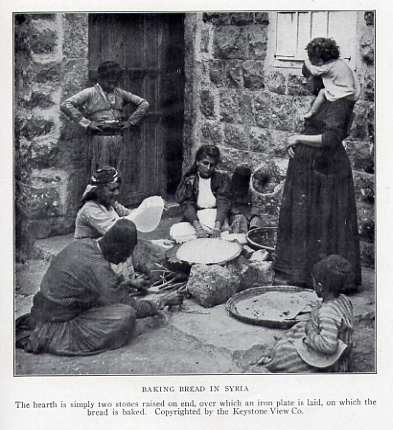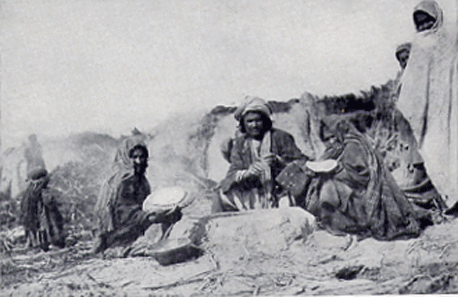
This photograph of “Baking Bread in Syria” was published a century ago in The National Geographic Magazine, March, 1908.

This photograph of “Baking Bread in Syria” was published a century ago in The National Geographic Magazine, March, 1908.

The late 14th century Egyptian savant al-Damiri was introduced in a previous post. His massive Hayat al-hayawan, mostly unknown in English texts, is a treasure trove of esoterica. One way of looking at esoterica is that it is useless information, frivolous and entertaining with little or no pedagogical value. I suppose the same could be said for many of the subjects taught on college campuses, past or present. The previous post focused on remarks about camels, but al-Damiri is not without his pragmatic advice for humans. After all, animals should be our friends and not just our dinner. The following recipe may have few takers in contemporary society, especially the overweight citizens of America; but just in case you ever wanted to know, here is advice on how to get fat:
If you wish a woman to become fat, take the fat of a goose (female), pound it and mix with it borax, Karmânî cummin-seed, and the flour of fenugreek, then mix all together with water, make it into bullets and get a black fowl to swallow them for seven consecutive days, after which it is to be killed and roasted; whoever partakes of it or its gravy will become so fat, as almost to be overpowered by the fat, whether the eater is a man or a woman; but if you wish a person to be still fatter than that, take human bile and place it over as much wheat as can be easily prepared with a little water, then wait until the wheat swells out, after which feed a black fowl on it, and do with the fowl as described before; whoever partakes of that fowl whether a man or a woman will see a wonder of wonders in the shape of obesity and fatness, so much so that he or she will not be able even to stand up; this is a wonderful and tried secret.
Given obesity rates in the United States, I would say that either al-Damiri’s secret is out or it really would be useless advice today.

by Omar Dewachi
On April 23 , the New York Times published an article, “A Bit of Old Baghdad With a Western Twist,†in its ‘Dining and Wine’ section, reviewing La Kabbr, an Iraqi restaurant in New York City. Instead of drawing on an expert of Iraqi cuisine, the author of the article chose to focus on the Times Bureau Chief in Baghdad, now the editor of the world section of the Times Magazine, who had spent 4 years covering the war. The article celebrated how this restaurant in New York has become a “clubhouse for journalists and officials who have spent time in Baghdad, and for Iraqi expatriates and Iraqi-Americans.†Aparisim (Byline, Bobby) Ghosh the Baghdad Bureau chief seems to speak as an authority of Iraqi cuisine when he is quoted in the article saying:
“I wonder why Iraqi cuisine is not more sophisticated,†he said. “It is essentially peasant food, which I happen to love because it fits my palate perfectly. But intellectually, you wonder why, with all of its influences, the food isn’t more complex.â€

Baking bread in Seyistan on the Afghan Border
[It is hard to find a society in the Middle East without a thriving history of bread preparation. Before the modern loaf and bleached flour assaulted our tastebuds, a variety of flat breads were baked, either in clay overs or other makeshift ovens. Here is a description of both Afghan and Turcoman bread making from a century ago, as reported by Ellsworth Huntington in the National Geographic Magazine in 1909. Webshaykh.]
The method of cooking it was very different from that employed in the oases, where ovens of mud shaped like beehives, with a hole in the top, are heated with a fire of weeds, and the dough is stuck against the inside of the hot oven, where it hangs until it is so far cooked that it falls down into the ashes. The bread of the Afghan caravan was cooked by heating small, round cobblestones in the fire and then poking them out and wrapping dough an inch thick about them. The balls thus formed were again thrown into the fire to be poked out again when cooked. The bread tasted well there in the desert, although in civilized communities the grit and ashes would have seemed unendurable. Continue reading Not your Daily Bread

Baking Bread in Syria: The hearth is simply two stones raised on end, over which an iron plate is laid, on which the bread is baked. Source: National Geographic Magazine, XIX(3):171, 1908.

‘Buns and Guns’ Fast Food Eatery Opens in Beirut
Asharq Alawsat, 27/06/2008
BEIRUT, Lebanon, (AP) – At the “Buns and Guns,” the chefs wear military helmets, the food is wrapped in camouflage paper and the advertising slogan is “a sandwich can kill you.”
The fast food eatery with a tongue-in-cheek military theme opened three weeks ago in Beirut’s Hezbollah-dominated southern suburbs and is drawing in residents proud of the Shiite militant group’s battlefield successes.
Done up like a military outpost, the restaurant is located in the heart of a neighborhood heavily pounded by Israel during its 2006 war with Hezbollah, which fought the Israeli military to a standstill.
Neatly stacked sandbags cover the exterior, while the inside is festooned with camouflage nets, defused mortar shells and live ammunition. Employees in military uniforms serve meals to the taped sounds of gunfire as “background music.” Continue reading Buns and Guns in Beirut

U.S. Embassy to Qat Chewers: quit now if you want an immigrant visa
By Sarah Wolff, Yemen Times,
SANA’A, March 31 — The United States Embassy in Yemen recently introduced a new provision for Yemenis seeking permanent residence in the U.S. Its message? Lay off your qat if you want to live in America.
Under this new stipulation, the U.S. Embassy will not issue immigration visas to anyone who is addicted to qat. Unites States law defines an “addict” as anyone who has used a drug for other than experimental purposes, i.e., more than one-time usage. This means that anyone in Yemen who has chewed qat more than once will have to medically prove that they are no longer using it in order to live in the United States.
U.S. law qualifies qat as a Schedule I controlled substance because it contains the chemical cathinone, which is a narcotic with addictive properties and has no known medicinal benefits. Abuse of Schedule I drugs is considered a “Class A” medical ineligibility under the Immigration and Nationality Act. Continue reading The Qat ate your visa
 The infamous “Black Sambo” image.
The infamous “Black Sambo” image.
Observations on the Baboons in the Garden of the “Bostan” Restaurant (Part Two)
[Note: These observations were first published in 1991 in Yemen Update and are archived online. The “Boston” has long since disappeared, but memories live on. For Part One, click here.]
Let me introduce you to the other guests besides myself, Flo and Eddy. At the table in front of me sat two Egyptian men who were soon joined by two Frenchmen. There was a rather abrupt shift from Cairene Arabic to French (or at least a form of French). What struck me was not the Egyptian or the French dialects, but the visual message on the back of a t-shirt worn by one of the French diners. This might have been purchased anywhere, of course, since all these designs are mumbo-jumbled internationally. First of all the color of the t-shirt was that of over-ripe banana pulp (it really was). Emblazoned on the back were four figures, each of them a replica of the racist “Black Sambo” image of Blacks in America during the “Amos ‘n Andy” era. One of these caricatures was boxing, another surfing, and so on. I suppose it was supposed to communicate nothing significant and for the most part it did here in Yemen. But I was somewhat appalled and was tempted to ask the fellow, whose back was a billboard for my face, to take off his shirt and wear it backwards (assuming only the over-ripe banana exuded on the front). Continue reading Observations on the Baboons in the Garden of the “Bostan” Restaurant (2)